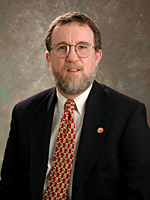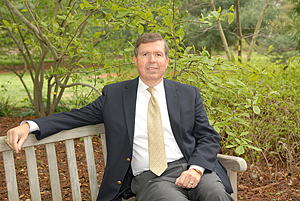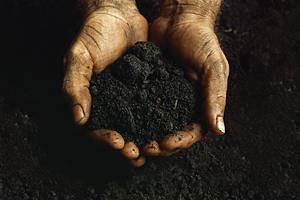

- Rozovsky wins prestigious NSF Early Career Award
- UD students meet alumni, experience 'closing bell' at NYSE
- Newark Police seek assistance in identifying suspects in robbery
- Rivlin says bipartisan budget action, stronger budget rules key to reversing debt
- Stink bugs shouldn't pose problem until late summer
- Gao to honor Placido Domingo in Washington performance
- Adopt-A-Highway project keeps Lewes road clean
- WVUD's Radiothon fundraiser runs April 1-10
- W.D. Snodgrass Symposium to honor Pulitzer winner
- New guide helps cancer patients manage symptoms
- UD in the News, March 25, 2011
- For the Record, March 25, 2011
- Public opinion expert discusses world views of U.S. in Global Agenda series
- Congressional delegation, dean laud Center for Community Research and Service program
- Center for Political Communication sets symposium on politics, entertainment
- Students work to raise funds, awareness of domestic violence
- Equestrian team wins regional championship in Western riding
- Markell, Harker stress importance of agriculture to Delaware's economy
- Carol A. Ammon MBA Case Competition winners announced
- Prof presents blood-clotting studies at Gordon Research Conference
- Sexual Assault Awareness Month events, programs announced
- Stay connected with Sea Grant, CEOE e-newsletter
- A message to UD regarding the tragedy in Japan
- More News >>
- March 31-May 14: REP stages Neil Simon's 'The Good Doctor'
- April 2: Newark plans annual 'wine and dine'
- April 5: Expert perspective on U.S. health care
- April 5: Comedian Ace Guillen to visit Scrounge
- April 6, May 4: School of Nursing sponsors research lecture series
- April 6-May 4: Confucius Institute presents Chinese Film Series on Wednesdays
- April 6: IPCC's Pachauri to discuss sustainable development in DENIN Dialogue Series
- April 7: 'WVUDstock' radiothon concert announced
- April 8: English Language Institute presents 'Arts in Translation'
- April 9: Green and Healthy Living Expo planned at The Bob
- April 9: Center for Political Communication to host Onion editor
- April 10: Alumni Easter Egg-stravaganza planned
- April 11: CDS session to focus on visual assistive technologies
- April 12: T.J. Stiles to speak at UDLA annual dinner
- April 15, 16: Annual UD push lawnmower tune-up scheduled
- April 15, 16: Master Players series presents iMusic 4, China Magpie
- April 15, 16: Delaware Symphony, UD chorus to perform Mahler work
- April 18: Former NFL Coach Bill Cowher featured in UD Speaks
- April 21-24: Sesame Street Live brings Elmo and friends to The Bob
- April 30: Save the date for Ag Day 2011 at UD
- April 30: Symposium to consider 'Frontiers at the Chemistry-Biology Interface'
- April 30-May 1: Relay for Life set at Delaware Field House
- May 4: Delaware Membrane Protein Symposium announced
- May 5: Northwestern University's Leon Keer to deliver Kerr lecture
- May 7: Women's volleyball team to host second annual Spring Fling
- Through May 3: SPPA announces speakers for 10th annual lecture series
- Through May 4: Global Agenda sees U.S. through others' eyes; World Bank president to speak
- Through May 4: 'Research on Race, Ethnicity, Culture' topic of series
- Through May 9: Black American Studies announces lecture series
- Through May 11: 'Challenges in Jewish Culture' lecture series announced
- Through May 11: Area Studies research featured in speaker series
- Through June 5: 'Andy Warhol: Behind the Camera' on view in Old College Gallery
- Through July 15: 'Bodyscapes' on view at Mechanical Hall Gallery
- More What's Happening >>
- UD calendar >>
- Middle States evaluation team on campus April 5
- Phipps named HR Liaison of the Quarter
- Senior wins iPad for participating in assessment study
- April 19: Procurement Services schedules information sessions
- UD Bookstore announces spring break hours
- HealthyU Wellness Program encourages employees to 'Step into Spring'
- April 8-29: Faculty roundtable series considers student engagement
- GRE is changing; learn more at April 15 info session
- April 30: UD Evening with Blue Rocks set for employees
- Morris Library to be open 24/7 during final exams
- More Campus FYI >>
3:29 p.m., Aug. 6, 2008----Did you know that there are more living creatures in a tablespoon of soil than there are people on the Earth? This and other fun soil facts are brought to life thanks to UD soil scientists, scientists from across the country and many state partners, in the newest exhibit at the National Museum of Natural History in Washington, D.C. “Dig It! The Secrets of Soil” opened July 19 and features 5,000 square feet of educational exhibit space dedicated to soil and its life-sustaining properties.
Tom Sims, associate dean for academic programs and research for UD's College of Agriculture and Natural Resources and the T. A. Baker Professor of Soil and Environmental Chemistry, and Don Sparks, S. Hallock du Pont Chair of Plant and Soil Sciences and director of UD's Center for Critical Zone Research, were instrumental in Delaware's contributions to the exhibit. The soils and environmental quality program at UD, in the Department of Plant and Soil Sciences, is nationally recognized for addressing soil resources as they relate to agricultural and environmental challenges.
These two prominent UD soil scientists served as president of the Soil Science Society of America (SSSA) in 2002-04 and 2000. respectively. Sparks also served as president of the International Union of Soil Sciences from 2002-06. During these time periods, they worked on exhibit development.
“Soil scientists throughout the U.S. worked with the design team at the Smithsonian for nearly eight years to create a world-class educational exhibit that illustrates the fundamental importance of soils to life on Earth," said Sims, who served on the steering committee for the project. "The SSSA took the lead in developing the exhibit, but we were very fortunate to have the support of the National Academies, hundreds of soil conservation districts, all major USDA agencies and the private sector in our efforts to raise the more than $2 million needed to create the 'Dig It' exhibit.”
Sims added, “As Pat Megonigal, lead curator for the exhibit and SSSA member stated, 'Soils represent the biggest gap between the importance of a natural resource and its appreciation by the public.' After viewing the exhibit, I'm confident that visitors to the Smithsonian will have a much greater understanding of how important soils are not only to food, fiber and energy production, but to sustaining the quality of our environment for future generations.”
“The exhibit is a wonderful way to showcase to the public the incredible role that soil plays in our daily lives,” Sparks said. “Soils are the foundation for life and are critical in sustainability of human welfare, ecosystem health, food production, carbon sequestration and an array of other areas.”
“Dig It!” uses interactive displays, hands-on models, videos and soil samples to guide visitors on a quest to learn more about soil as an often overlooked but vastly important resource and ecosystem. Through the 5,000-square-foot exhibit, visitors will look at the “skin” of the Earth, see how soils are formed and learn about their characteristics, learn how soils play a part in both life and death, investigate how soils are important to environmental issues like water quality and global warming, and find out how soils play an important role in the everyday life of everything from worms to people.
There is even an interactive exhibit that highlights each state's soil, including Delaware's own Greenwich loam. In 2000, then Gov. Thomas R. Carper, through the sponsorship of state Rep. V. George Carey, signed House Bill 436 establishing Greenwich loam as the official state soil of Delaware. When the exhibit commenced development and the SSSA was looking for supporters, Carey approached the Delaware State legislature for support.
“If we are good stewards of the soil, it can provide for us forever," said Carey, who farms in the Slaughter Neck area near Milford, Del. "Soil will give back to us what we put into it. This exhibit will help people to understand how important soil is not only to farmers, but to everyone.”
Each state was asked to raise funds to support its state's soil exhibit. “We are grateful for the generous support of the exhibit by a number of Delawareans, the state legislature through the efforts of Rep. George Carey, and the Sussex County Council,” Sparks said,
UD alumni working in the soil sciences also were instrumental in contributing to Delaware's efforts. The Carski Foundation, with encouragement from alum Ted Carski, AG '86 Ph.D., made significant contributions to reach the fundraising goal.
“The foundation is a family foundation, initiated by my grandfather to support education," said Carski, a global registration product manager for DuPont Crop Protection, a member of the UD College of Agriculture and Natural Resources advisory board and an adjunct professor in the Department of Plant and Soil Sciences. "This exhibit fits perfectly in terms of educating others about the importance of soils not only for agriculture but environmental quality.”
“We are also grateful to the Mid-Atlantic Association of Professional Soil Scientists (MAPSS),” said Sims. “They also helped to raise the funds needed for the Greenwich soil exhibit, and made many personal contributions to the Smithsonian for the new exhibit.”
“It was definitely a group effort," said Ian Kauffman, a MAPSS member and supporter of the project. "We had so many different people, professionals and nonprofessionals alike, who contributed individually and through their businesses. When we first started fundraising for the exhibit, Hurricane Katrina hit. In the spirit of pulling together for the exhibit, MAPSS made a contribution to the exhibit in the name of Louisiana's professional association of soil scientists, helping to get them their state soil exhibit.”
At the conclusion of the exhibition at the National Museum of Natural History on Jan. 3, “Dig It!” will travel to 10 museums throughout the U.S. through 2013 via the Smithsonian Institution Traveling Exhibition Service.
Additional information about “Dig It! The Secrets of Soil” is available online from the Smithsonian at [http://forces.si.edu/soils] and on the Soil Science Society of America Web site at [https://www.soils.org/smithsonian].
The National Museum of Natural History is located at 10th Street and Constitution Avenue N.W. in Washington, D.C., and is open daily from 10 a.m.-7:30 p.m. through Sunday, Aug. 31, and from 10 a.m.-5:30 p.m. thereafter. Admission is free.
More information about the museum is available at [www.mnh.si.edu] or by calling Smithsonian information at (202) 633-1000.
Article by Katy O'Connell, AG '00




